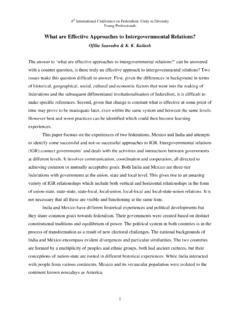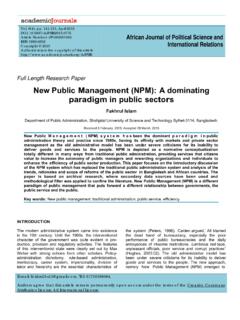Transcription of Introduction: Principles of Fiscal Federalism
1 introduction : Principles of Fiscal Federalismanwar shahA large and growing number of countries are re-examining the roles of var-ious orders of government and their partnerships with the private sectorand civil society in order to improve their ability to serve their people moreeffectively and efficiently. This rethinking has led to a resurgence of inter-est in the Principles and practices of Fiscal Federalism . Federal systems areseen to provide safeguards against the threat of centralized exploitation aswell as decentralized opportunistic behaviour while bringing decision mak-ers closer to the people. The Principles of Fiscal Federalism are concernedwith the design of Fiscal constitutions that is, how taxing, spending, andregulatory functions are allocated among governments and how intergov-ernmental transfers are structured.
2 These arrangements are of fundamen-tal importance to the efficient and equitable provision of public chapter begins by reviewing basic concepts in Federalism . This isfollowed by a discussion of the conceptual underpinnings of federal fiscalconstitutions. The Principles of Fiscal Federalism outlined in this chapter areprimarily based on economic premises; hence, they are limited in their ap-plication to economic criteria . Some nations may well consider political, so-ciological, and historical criteria of greater relevance in their discussion of the conceptual basis of expenditure assignment isfollowed by a review of the theory of tax assignment. Tax-base and reve-nue-sharing concepts and transfer mechanisms are then introducedbriefly. A concluding section brings together the main themes of thefiscal Federalism concepts of federalismConstitutional divisions of powers among various orders of government fallinto three categories: unitary, federal, and Page 3 Tuesday, July 3, 2007 11:48 AM4 Anwar ShahUnitary GovernmentA unitary country has a single or multi-tiered government in which effec-tive control of all government functions rests with the central unitary form of government facilitates centralized decision making tofurther national unity.
3 It places a greater premium on uniformity andequal access to public services than it does on diversity. An overwhelmingmajority of countries (148 of 193 countries in 2006) have a unitary formof government. The city-states of Singapore and Monaco are single-tieredunitary governments. China, Egypt, France, Indonesia, Italy, Japan, Korea,New Zealand, Norway, the Philippines, Portugal, Sweden, Turkey, and theUnited Kingdom have multi-tiered governments based on unitary constitu-tions. As a result, some unitary countries ( , China, Denmark, Norway,and Sweden) are more fiscally decentralized than are some federal coun-tries, such as Australia and India. Federal GovernmentA federal form of government has a multi-order structure, with all ordersof government having some independent as well as shared decision-making responsibilities.
4 Federalism represents either a coming together or a holding together of constituent geographic units to take advantageof the greatness and smallness of nations in a flat (globalized) world inwhich many nation-states are too large to address the small things in lifeand too small to address large Subscribing to the coming together view of Federalism , Daniel J. Elazar pointed out and elaborated that theword Federalism has its roots in the Latin foedus, meaning league, treaty, or compact. 2 More recently, Robert Inman noted that the word federal has come to represent any form of government that brings to-gether, in an alliance, constituent governments each of which recognizesthe legitimacy of an overarching central government to make decisions onsome matters once exclusively the responsibility of individual memberstates.
5 3 Coming together has been the guiding framework for maturefederations such as the United States, Canada, and, more recently, the Eu-ropean Union. The alternative holding together view of Federalism , alsocalled new Federalism , represents an attempt to decentralize responsibili-ties to state-local orders of government with a view to overcoming regionaland local discontent with central policies. This view is the driving force be-hind the current interest in Principles of Federalism in unitary countriesand in relatively newer federations such as Brazil and India and emergingfederations such as Iraq, Spain, and South Africa. A federal form of government promotes decentralized decision makingand, therefore, is conducive to greater freedom of choice, diversity Page 4 Tuesday, July 3, 2007 11:48 AMIntroduction: Principles of Fiscal Federalism 5preferences in public services, political participation, innovation, It is also better adapted to handle regional conflicts.
6 Sucha system, however, is open to a great deal of duplication and confusion inareas of shared rule and requires special institutional arrangements tosecure national unity, ensure regional equity, and preserve an internalcommon countries broadly conform to one of two models: dual federalismor cooperative Federalism . Under dual Federalism , the responsibilities of thefederal and state governments are separate and distinct. According toWilliam H. Riker, under such a system, two levels of government rule thesame land and the people, (2) each level has at least one area of action inwhich it is autonomous, and (3) there is some guarantee .. of the auton-omy of each government in its own sphere. 5 Under cooperative federal-ism, the responsibilities of various orders are mostly interlinked.
7 Underboth these models, Fiscal tiers are organized so that the national and stategovernments have independent authority in their areas of responsibilityand act as equal partners. National and state governments often assumecompetitive, non-cooperative roles under such an arrangement. Dual fed-eralism takes either the layer cake or coordinate-authority approach. Underthe layer-cake model, practised in Mexico, Malaysia, and Russia, there is ahierarchical (unitary) type of relationship among the various orders ofgovernment. The national government is at the apex, and it has the optionto deal with local governments either through state governments or moredirectly. Local governments do not have any constitutional status: they aresimply extensions of state governments and derive their authority fromstate governments.
8 In the coordinate-authority model of dual Federalism ,states enjoy significant autonomy from the federal government, and localgovernments are simply handmaidens of the states and have little or no di-rect relationship with the federal government. The working of the federa-tions of Australia, Canada, India, Pakistan, and the United States resemblesthe coordinate-authority model of dual cooperative Federalism model has, in practice, taken three forms: in-terdependent spheres, marble cake, and independent spheres. In theinterdependent spheres variety as practised in Germany and South Africa(a unitary country with federal features), the federal government deter-mines policy, and the state and local governments act as implementationagents for federally determined policies.
9 In view of federal domination ofpolicy making, in this model, state/provincial governments have a voice infederal policy making through a second chamber (the upper house of theParliament). In Germany and South Africa, the second-order (state) gov-ernments are represented in the upper house of the national parliament(the Bundesrat and the Council of the Provinces, respectively). In the mar-ble cake model of cooperative Federalism , various orders of Page 5 Tuesday, July 3, 2007 11:48 AM6 Anwar Shahhave overlapping and shared responsibilities, and all constituent govern-ments are treated as equal partners in the federation. Belgium, with itsthree territorial and four linguistic jurisdictions, has a strong affinity withthis approach. Finally, in a model of cooperative Federalism with indepen-dent spheres of government, all orders of government enjoy autonomousand equal status and coordinate their policies horizontally and is the only federation practising this form of competitive Federalism model is a theoretical construct advanced bythe Fiscal Federalism literature and not yet practised anywhere in its pureform.
10 According to this construct, all orders of government should haveoverlapping responsibilities, and they should compete both vertically andhorizontally to establish their clientele of Some analysts arguethat such a competitive framework would create leaner and more efficientgovernments that would be more responsive and accountable to with a federal form of government vary considerably in terms offederal influence on subnational governments. Such influence is very strongin Australia, Germany, India, Malaysia, Mexico, and Pakistan; moderatelystrong in Nigeria and the United States; and weak in Brazil, Canada, andSwitzerland. In the last group of countries, national control over subnationalexpenditures is quite limited, and subnational governments have consider-able authority to determine their own tax bases and tax rates.





